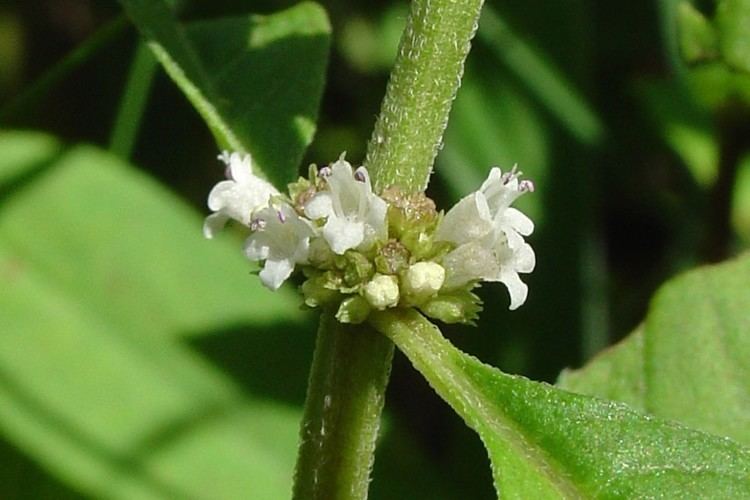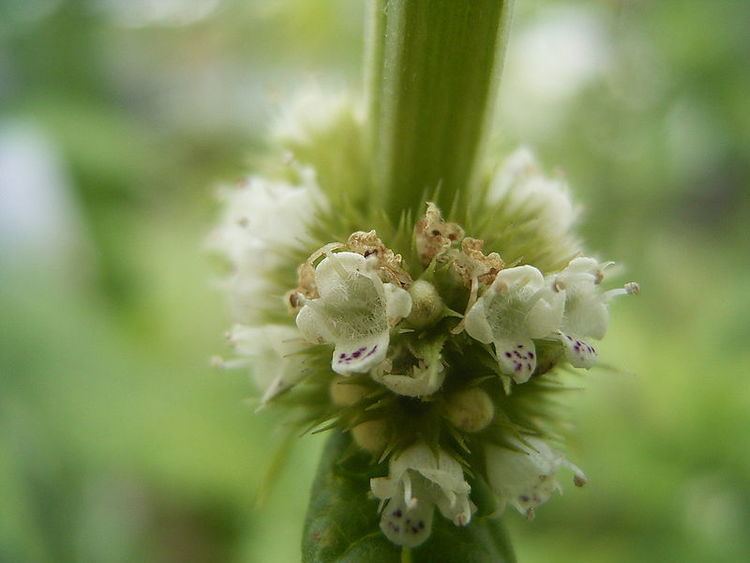Scientific name Lycopus Rank Genus | Higher classification Nepetoídeae | |
 | ||
Lower classifications Lycopus europaeus, Lycopus americanus, Lycopus asper | ||
Gipsywort lycopus europaeus european bugleweed 2012 07 14
Lycopus (waterhorehound, gypsywort, or bugleweed) is a genus in the family Lamiaceae. They are all herbaceous plants native to Europe, Asia, Australia, and North America. The species are most often found in wetlands, damp meadows, and stream banks. Some of the wetland species have become endangered.
Contents

Appearance

The genus includes only perennial species; they spread by both seeds and stems rooting as they grow along the ground. Small white flowers bloom in late summer on leaf axials. Leaves are bright green, pointed, lobed, and like all mints occur in opposite pairs. Some species start with curled purple leaves that unfurl to a bright green coloration. The species in this genus vary in size, but generally grow to about 3–4 feet.
Ethnobotanical history

The plant's juice yields black dye, supposedly used by the Roma to tan their skin to mimic Egyptians in Europe, and hence the common name of Gypsywort for Lycopus europaeus. Apothecaries and herbalists use the leaves, stems, and flowers for their astringent and sedative qualities as well as for anxiety, tuberculosis, and palpitations. Some species of the herb also may have narcotic and contraceptive effects. Extracts may have benefits in Graves' disease.

- Lycopus alissoviae Prob. - Primorye region of Russia
- Lycopus americanus Muhl. ex W.P.C.Barton - American bugleweed - widespread across most of United States and Canada
- Lycopus amplectens Raf. - eastern United States
- Lycopus angustifolius Elliott - southeastern United States
- Lycopus asper Greene - rough bugleweed - western Canada, western + central United States
- Lycopus australis R.Br. - Australian Gypsywort - Australia
- Lycopus cavaleriei H.Lév. - Korean bugleweed - China, Japan, Korea, Sakhalin, Kuril Islands
- Lycopus charkeviczii Prob. - Primorye region of Russia
- Lycopus cokeri H.E.Ahles ex Sorrie - North Carolina, South Carolina
- Lycopus europaeus L. - Gypsywort - Europe, North Africa, northern Asia; naturalized in New Zealand and North America
- Lycopus exaltatus L.f. - central + eastern Europe, Siberia, Central Asia, Xinjiang, Caucasus, Western Himalayas
- Lycopus hirtellus Kom. - Primorye region of Russia
- Lycopus × intermedius Hausskn. - Germany, Austria, Czech Republic, Greece (L. europaeus × L. exaltatus)
- Lycopus kurilensis Prob. - Kuril Islands
- Lycopus laurentianus Roll.-Germ. - Quebec
- Lycopus lucidus Turcz. ex Benth. - Traditional Chinese Medicine herb to make Lycopi rhizoma - China, Japan, Korea, Siberia, Russian Far East
- Lycopus rubellus Moench - central + eastern United States
- Lycopus × sherardii Steele - Quebec, Ontario, eastern United States
- Lycopus sichotensis Prob. - Primorye region of Russia
- Lycopus uniflorus Michx. - northern bugleweed - Canada, United States. China, Japan, Korea, Russian Far East
- Lycopus virginicus L. - Virginia bugleweed/water-horehound - central + eastern United States

